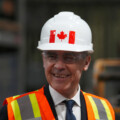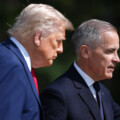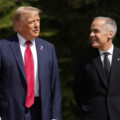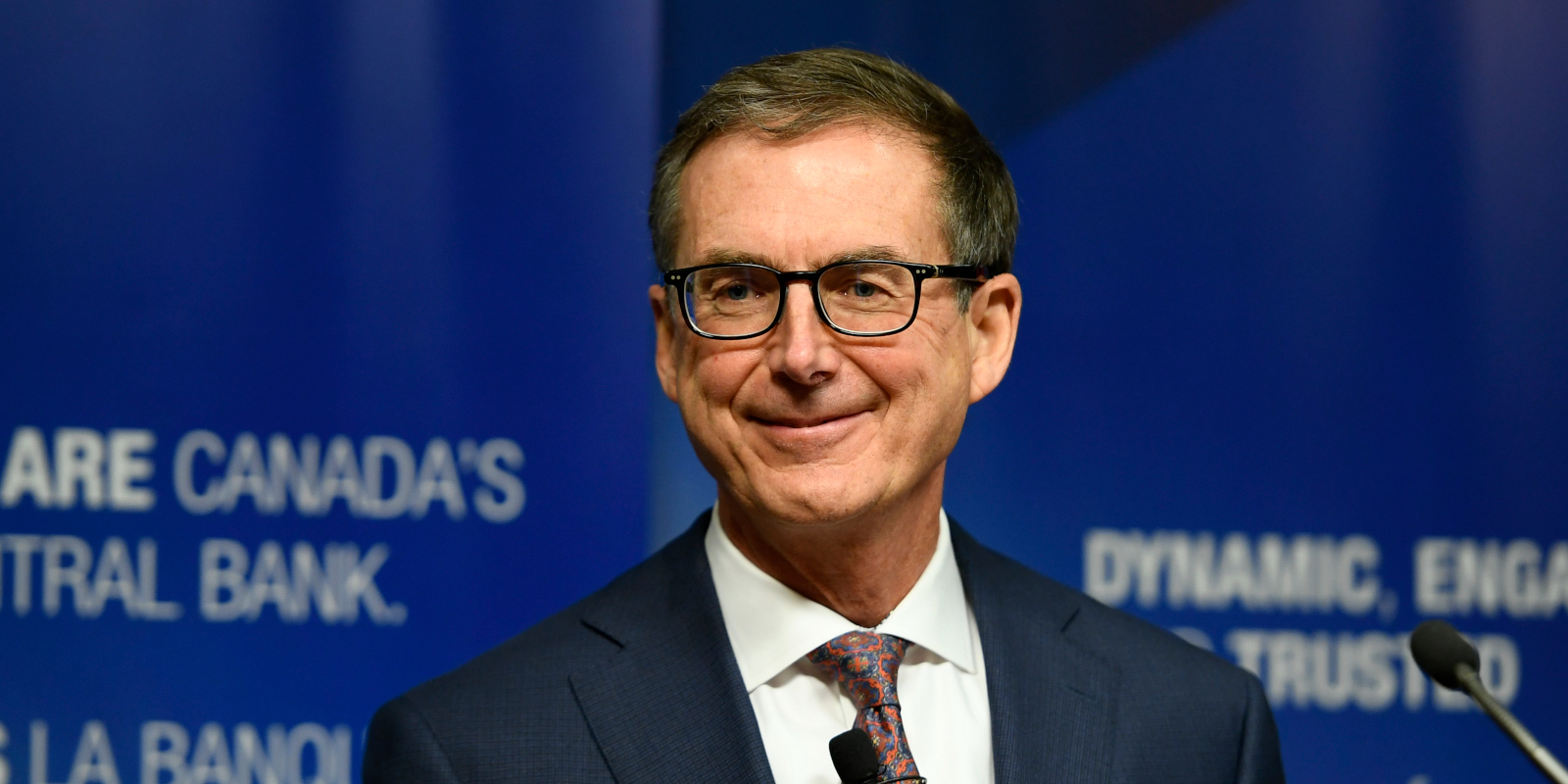Economist Chris Ragan joins today’s episode of Hub Dialogues to discuss the proper role of central banks, the problems with Modern Monetary Theory, and the need to rethink our fiscal priorities as we look to recover from the devastation of the pandemic.
You can listen to this episode of Hub Dialogues on Acast, Amazon, Audible, Apple, Google, Spotify, or YouTube. A transcript of the episode is available below.
Transcripts of our podcast episodes are not fully edited for grammar or spelling.
SEAN SPEER: Welcome to Hub Dialogues. I’m your host, Sean Speer, editor-at-large at The Hub. I’m honored to be joined today by Chris Ragan, the founding director of the Max Bell School of Public Policy at McGill University. Chris is the author of one of the most widely used introductory economics textbooks in Canada. He’s a brilliant macroeconomist who published dozens of books and articles and advises governments on a range of topics including public finance, carbon taxes, and monetary policy. I’m grateful to be able to speak with him about fiscal and monetary policy in general, and the growing salience of Modern Monetary Theory in particular.
Chris, let’s start by contextualizing our conversation with how we’ve tended to think about fiscal and monetary policy over the past quarter-century or longer. Broadly speaking, how would you describe the conventional wisdom with respect to deficits and debt on one hand, and the interrelationship between fiscal and monetary policy, on the other hand?
CHRISTOPHER RAGAN: Okay, I guess I would start by saying that I think the conventional view is that fiscal policy is really about two things. One thing is you come up with a way to raise the revenues that you need to finance all of the spending that you do. And there’s a huge amount that goes into that. There’s a huge amount that goes into what you decide public spending will be on and what it won’t be on, and there’s a huge amount that goes into how we figure out how we want to raise the tax revenue required for that. That’s one big bundle of things.
And then the second big bundle of things with fiscal policy is to what extent do you want to use Keynesian style fiscal stimulus when you are confronted with a weakening economy or a slumping economy. And I think there is a fair amount of agreement that has been for many years, that fiscal stimulus is a potentially very important tool. You probably don’t want to respond to every bump and wiggle in the economy, but you can certainly respond with well-designed fiscal stimulus packages to big shocks, like we saw in the 2008-2009 financial crisis. That’s a very good example. So, to me, that’s kind of all fiscal policy. And notice, nowhere in there did I mention the central bank, nor did I mention inflation. Okay, so, part of this conventional wisdom has been the division of duties.
All of those things that I just talked about were kind of left to fiscal policy, and the corollary is that the central bank would focus its attention on stabilizing the economy. So there, they overlap with the Keynesian fiscal stimulus, but they would be really keeping their eye on inflation. And they would be directing their very limited number of policy instruments, which is really the central bank’s balance sheet, to the control of inflation. And we can talk a little bit more about, you know, what is involved in the control of inflation. But really, there has been this division of duties with taxes and spending and deficits on one side—deficits or surpluses, I should say—and with monetary policy and inflation on the other side.
The one final thing I will say in that is that, in this conventional thinking, there has been the belief of what is sometimes referred to as monetary dominance: the idea that if the fiscal authorities end up spending a lot or cutting their spending or adjusting their taxes, it, of course has an effect on the aggregate economy. It may, in fact, have an effect on the amount of aggregate demand or deficient demand in the economy, and that may have implications for inflation, but if the central bank is doing its job, then it can sort of counteract some of the negative inflationary aspects that come from that fiscal policy. Basically, so the fiscal authority wouldn’t have to worry about that. Securing the knowledge at the central bank sort of had that covered. So, that is my long-winded way to characterize that division of duties between fiscal and monetary policy.
SEAN SPEER: How much is the renewed interest in deficit spending driven by a basic political economy challenge? Let me put this proposition to you. On one hand, the public seems to want more government spending but, on the other hand, it doesn’t seem prepared to fully pay for it. An empirical way to make this point may be that public spending as a share of GDP is up, but revenue as a share to GDP is generally flat. Is that a sign that Canadians and others in advanced economies want big government on the cheap? If so, are deficits an imperfect way to solve for this dissonance in our political preferences?
CHRISTOPHER RAGAN: Okay, I would say there were two questions there. So, one invites a little bit of history, and the other is about our current belief in getting something for nothing. I actually think just to end—to start with where you ended, I actually think there is a lot behind what you just said that, I think there’s a belief that you can get a bunch of a government on the cheap. I think, as you said, “Why raise taxes, if you can just put it on the credit card?” kind of thing. But I’ll come back to that.
I want to talk—to start by talking a little bit about the history. Because, and I won’t go back that far, I’ll go back to the mid 1990s. When the Canadian government, the federal Canadian government had a 68 percent debt-to-GDP ratio, the provincial the aggregate provincial debt-to-GDP ratio was about 22 percent. So, the combined federal-provincial debt ratio was about 90 percent of GDP. This is when we thought as a country we had hit the “debt wall,” and some bad things happened in financial markets.
I think there was a general belief that maybe Canada wouldn’t be able to pay back its debt, or at least there were some questions raised about the extent to which that would be possible. Both provincially and federally, we embarked on a pretty serious fiscal consolidation over the next few years. And even though for 15 years, there were many people from the 1980s and early 1990s that had talked about the dangers of high government debt, it really didn’t, you know, the rubber didn’t really hit the road on this issue until the early- to mid-1990s, and then we embarked on this fiscal consolidation.
So of course, Paul Martin, who was the finance minister at the time; Jean Crétien was prime minister, and under their leadership, we brought very large fiscal deficits into actually pretty substantial fiscal surpluses in a pretty short amount of time, and pretty quickly the debt-to-GDP ratio was falling. And as you know, by the time we got to 2008, just before the financial crisis, our federal debt to GDP ratio was just about 30 percent—I mean, plus or minus a very small amount. So that was quite a change.
And what was interesting politically, before the financial crisis happened, is that we had come to the point in this country where even the NDP, I mean, quite apart from the Liberals and the Conservatives, but even the NDP in the mid 2000s were agreeing that high public debt really is a problem, we really should be very careful about budget deficits, and we should actually be balancing the budgets. The political convergence on that point was actually quite shocking. One can argue whether it was good or bad, but it was quite surprising.
Then the financial crisis happened, and it took a while, but—Stephen Harper was prime minister and Jim Flaherty was the finance minister—it took a while for them to believe that there would be a recession, and it took a while for them to really believe that we needed some sort of Keynesian fiscal stimulus. But the G20 countries got together in the fall of 2008 and they all agreed to kind of go back home to their national capitals and to embark on a pretty sizable two-year fiscal stimulus package. We did, other countries in the G20 did, and I think it was, it was a very good thing that we did. I mean, given the nature of the financial crisis, given the nature of the collapse in aggregate demand and the massive uncertainty, I think a big fiscal stimulus—and over those two years that amounted to something like five or six percent of GDP—the fiscal stimulus, I think, was relatively well-designed, and I think it was well motivated. And at that point, of course, there wasn’t a huge amount of political opposition to that fiscal stimulus.
So now, what had just two years or a year before been a unanimous political view that we should be balancing budgets, now was a view that a fiscal deficit was okay. But of course, the deficits lasted only for a few years; the debt-to-GDP ratio increased and then sort of came back down again. And by the time we got to just before the pandemic, our debt-to-GDP ratio federally was again back down to something like 30 or 31 percent. It was pretty low. I mean, maybe I’m off by a percentage point, but nothing serious. And then what, of course, what we’ve been confronted with is the pandemic. And the pandemic is not only a huge shock, but it’s a very, very different economic shock than the financial crisis of 2008-9.
And so, what we embarked on was massive deficit spending, but not stimulus spending. And I think that’s a really important distinction, is so that the federal government—you know, Justin Trudeau has been saying now for the last few, the last two years, that, “We have your back.” And you know, and what he meant, by that, I think, or my fiscal interpretation of what he meant by that was, you know, “We will make sure that the financial relief is there for you, for households for small businesses, even for some large businesses, while your income has basically disappeared because of the requirement that people stay at home and isolate safely, and you know while your income generating ability has disappeared, we will provide the financial relief.”
That has not been stimulus spending in the usual way; it’s not designed to increase aggregate demand, it’s really designed to allow you to pay your mortgage and to buy groceries, etc. And of course, those last two years, our deficits have gone literally off the charts, off most charts, and that’s been true in most advanced countries. Though, if Omicron is the last wave, then the budget deficits will eventually get back down to something closer to zero; the debt-to-GDP ratio will come on down, and you saw in the Fiscal Update, there is a path, hopefully that will happen, that has that debt-to-GDP ratio coming back down slowly. It’ll be a long time before it gets back to the low-30s, but it will get back to the low-40s within several years.
So, we’re now in this situation where I think for very, very good reasons, we had very large budget deficits over the past couple of years; there was some relief spending that I think needed to be done, and the government I think deserves credit for designing those packages. But, and the but here comes to your second point, which is, are we now in this situation where we kind of think that we can just spend on lots of things and not actually pay for them? We’re so used to, like in the last 18-22 months, we’re so used to putting things on the charge card, that I actually think there is this growing belief that maybe we can just keep spending, and we don’t have to raise current taxes to pay for it. And in a world of very low interest rates, it is true that you can put things on the, you know, you can borrow to finance those expenditures, and you are putting the cost onto the future, but you’re putting a low cost onto the future, because those interest rates are so small.
And one of my concerns is that the current finance minister and the current federal government are not talking enough about the future and to what extent should we be rethinking government spending priorities—to what extent should we be hastening the decline in the debt-to-GDP ratio. Because there will be another recession of some sort. There will be either another financial crisis or another pandemic or another something that we can’t even imagine, and there will be a need to lower that debt-to-GDP ratio, so that you provide the fiscal room so that the government can respond to the next event whenever and whatever it is.
But I think my criticism here is that the government is not really thinking enough or talking enough about the need to rethink fiscal priorities; the need to think about possible tax increases; the possibilities of what might happen if interest rates rise. All of that is just not being talked about, in my estimation.
SEAN SPEER: Well, thank you for that comprehensive answer, Chris, from recent fiscal history to a discussion of the future, which is a good segue to my next question.
You outlined concerns that the government isn’t thinking about how to close the gap between its spending ambitions and the revenue it collects. But there are some who would argue that they don’t need to, which brings us to the conversation that I want to have with you about Modern Monetary Theory. Maybe just to start definitionally, where did it come from? And in the fairest possible terms, what’s the general proposition behind Modern Monetary Theory?
CHRISTOPHER RAGAN: So those questions sounds simple, but they’re not quite so simple [LAUGHS]. So let me do the first one. Where does it come from? I think some of the ideas about MMT have actually been around for a long time. But it’s the last 10 or 12 years where we have seen a couple of things happen. We have seen the big financial crisis in 2008-9 and we’ve seen the pandemic in the last, you know, what we’re living in right now. And the policy responses to both of them those had, number one, large amounts of government spending—much larger in the pandemic than in the financial crisis, but a large increase in government spending in both cases. And in both cases, central banks that increase their balance sheets, they increase their amount of large asset purchases through printing of money. So, quantitative easing. Now, that didn’t happen in Canada in 2008, but it did happen in Canada during the pandemic right now. And it happened in the United States and in the Bank of England, and in the European Central Bank, both in the financial crisis and now.
So, I think this confluence of these two things: we’ve got big economic shocks, we’ve got the central bank printing a lot of money and using that freshly printed money to buy government and other bonds. And at the same time, we’ve got government spending a huge amount of money on the fiscal side, and I think that has brought— it’s come together, and people have said, they’ve kind of dusted off these old ideas that, “Oh, well, maybe we can just print money to finance the government’s budget deficits. And maybe that’s not so bad and let’s wrap that all up, and we’ll call that Modern Monetary Theory.” Okay, so I think that’s where it has come from, or at least why it’s been dusted off in the last few years.
What is it at its heart? Well, this is actually tough. I mean, I, last year, I was teaching in the MPP program at Max Bell, and I teach in the macro class, and I wanted to teach a section on monetary policy in theory, but I also wanted to cover off MMT. So, it forced me to go away and read a bunch of stuff on MMT. And I was shocked at how hard it was to figure out what it was. Because there are times when you kind of think, “Well, hold on, there’s nothing new here.” And then there are other times when you think, “Well, I’m not sure if there’s anything at all here.” And then there are times when you kind of read something and you think, “Well, I think this is just wrong.”
And so, here’s the way I would describe MMT. I think MMT is a belief that if you are a government that has your own central bank, that can create its own currency, then you don’t have to worry so much about running budget deficits and all of the constraints that ordinarily we would think of as being associated with budget deficits, because you can effectively get your central bank to purchase your bonds, and you own the central bank, so you can get your central bank to print the money required to buy your bonds.
Now, that was always true. Any government that had a central bank could always do that. But the MMT people think, or they seem to think if it’s my interpretation here, that you not only can do that, but you should do that, and you shouldn’t require your central bank to worry too much about inflation; you should worry about inflation through adjusting your spending and your taxation. So, it’s really a way to subsume the central bank into the fiscal authority.
And if you go back to our first question, that sort of division of duties between fiscal policy and monetary policy, my interpretation of MMT is that they have completely stuck these two things together by subsuming the central bank into the fiscal authority, so that the central bank would no longer be operationally independent; it would no longer be focused on inflation. In fact, it would no longer be in the headlines at all, because the fiscal authority would be basically taking charge of the central bank. And you could do that, you absolutely could do that. The question is whether you want to do that. I think this is technically possible. I think the fundamental question is, is this a good way to run policy?
SEAN SPEER: Isn’t it the case, Chris, that we collectively, not just Canada, but dozens of jurisdictions around the world, established an independent monetary policy authority precisely because the evidence over decades was that politics couldn’t be trusted with managing the question of inflation? So, in effect, wouldn’t this be a reversion to the politicization of inflation management?
CHRISTOPHER RAGAN: So, I agree with everything that you just said, and I think that is a correct reading of the 1950s, 1960s, and 1970s. I think there was a growing recognition that countries with less independent central banks tended to have higher inflation, and they tended to have higher inflation because the politics got into the mix. And, you know, the government would basically encourage the central bank to goose the economy before an election, so to speak, and you’d end up with higher inflation as a result. And so, there was a worldwide movement toward more independent central banks, and taking the politics out of it to the extent possible, and a recognition, a growing recognition as well, Sean, that central banks couldn’t do everything. That inflation was fundamentally a monetary phenomenon in a sustained way, that, you know, bumps and wiggles in inflation may be caused by all kinds of things. But if you really wanted to understand what the long-run effects of monetary policy were, they ended up being largely on inflation.
So, once you’ve concluded that monetary policy can’t control a lot of things, but it does seem to have a systematic and sustained influence on inflation, then, I’d like to say it’s a kind of a hop, skip and a jump to saying, “Well, we should have central banks focus on inflation.” It just took us 50 years to really get to that recognition. We’re slow learners, I guess. But there has been this absolute recognition that there is benefits to having central banks being operationally independent, focusing their attention on inflation, and the last, basically, 30 years—Canada was the second country to embark on inflation targeting after New Zealand in 1991— and for 30 years, we have been targeting inflation. Inflation has been low and stable and relatively predictable, and, and therefore the costs associated with high inflation haven’t been there.
So, I think you’re quite right. I think the MMTers who want to subsume the central bank into the fiscal authority, are effectively saying, “We don’t like an independent central bank; we don’t want the central bank to focus on inflation. Also, we don’t like the constraints on a government that are put on in private capital markets about whether people will buy our bonds or not. Why don’t we just have the central bank buy the government bonds?” And so, I think there really is a stated preference for a policy framework that I think there’s very good reasons why we don’t have used that policy framework currently. And I think MMTers are really wanting to go back to a very different world, and I would argue that it’s not a good world to be in.
SEAN SPEER: Your answer reminds me of our excellent Dialogue from late last year in which you joined me to talk about the pending decision on renewal the Bank of Canada’s inflation target. Listeners will recall that you made the case then that the Bank of Canada ought to be focused like a laser on its inflation target and not take on other policy responsibilities with respect to inequality, or climate change, or any number of issues that were being discussed in the context of renewing the mandate.
What you just outlined, it seems to me, implies that the central banks are facing pressure on both sides. On one hand, there are those who want to add a host of non-inflation issues to their respective mandates. And on the other hand, you have MMTers, who, in effect, want to strip them of their core mandate and hand it to the fiscal policy authorities. Do you want to maybe just outline your thoughts on what I think you’ve described as a two-front war facing central banks in advanced economies?
CHRISTOPHER RAGAN: Yeah, I think that’s exactly right. I’ve been thinking about writing this up, and I guess maybe I should do that one of these days. But I actually do think that central banks are currently finding themselves in a two-front war. The MMTers are effectively saying, “Let’s take away the central bank’s independence, and let’s take away its, its mandate on inflation.” So, those are people who are just basically stripping the central bank of power. And on the other side, there are people who seem to believe that the central bank is capable of not only controlling inflation, but doing so much more. And so, let’s have them deal with reducing income inequality and let’s have them address climate change. Let’s have them possibly help on the front of Indigenous reconciliation, and maybe there’s some other things we could have the central bank to as well.
It’s really quite ironic because the MMTers either don’t believe the central bank should have the power that it does, or maybe it just doesn’t think maybe it is trusted with the power. But the other people are wanting to get the central bank to do much more than they’re currently doing. They’re not trying to get them to switch from inflation into something else, they’re trying to get them to do inflation and a few other things. And so, maybe as long as that two-front war is going on, maybe the outcome of that two-front war is that we just kind of stay with the status quo. And we go, “Okay, well, let’s just leave the central banks to target inflation, and maybe that’s what we’ll do.” And that would be, in my view, that would be a good outcome, because I do think central banks have been successful in dealing with inflation. And I do think you do not want to combine the central bank with the fiscal authority, because effectively you’re giving up a policy instrument, which I think is a bad idea.
But at the same time, I also think there are serious limitations on what central banks can do, and I think it would be a big, big mistake to expand their mandate to climate change or income inequality or other things. So, that maybe just makes me sound like an old conservative guy, and maybe I’m just an old conservative guy, but I think that central banks should actually stick to their knitting. And they’ve actually, I think, shown that they can stick to their knitting, and they can do very well.
Now, some people might say, “But, but we haven’t had great economic outcomes. We’ve had a financial crisis; we’ve had a pandemic.” And I would say, “Well, that may be true that we have not had all the great economic outcomes we’d had like, but I don’t think most of that can be laid at the door of monetary policy.” I think monetary policy has done quite a good job in Canada and in other countries in keeping inflation low and stable. And I happen to share the view based on lots of evidence and theory over many years in many countries, that that’s all central banks are actually able to do. I don’t ask that much of my central bank, and I’m happy when all they do is deliver low and stable inflation.
SEAN SPEER: Well, let’s just wrap up Chris with a couple of final questions that speak to the motivations behind of Modern Monetary Theory and its likely influence.
I mean, at some level, it seems to me, these are people whose preferences are for a more ambitious role for government that would necessitate higher levels of spending, but who seem to be making the political economy assumption that the higher levels of taxation necessary to carry out their programme is politically unpalatable. And so MMT has become something of an alternative to the higher rates of taxation that would be required.
But what if a politician or political party made a straightforward argument that spending and taxes should rise as a share of GDP in the name of fully funding an expansion of the welfare state or some other public purpose? Is that okay? Are there empirical limits on the optimal size of government?
CHRISTOPHER RAGAN: Oh, okay, so this is a fabulous question, Sean. And it’s not the easy one. This is the 64-gazillion dollar question. It’s how big do you want government to be? And I think you can have a very healthy, very interesting debate and disagreement about how big government should be.
There’s no right answer to this. So, if you look at the scale of government in the Scandinavian countries, it is larger as a share of the economy than it is in sort of Western European countries. And in Western European countries, it’s higher than it is in Canada, which in turn is higher than it is in the United States. I mean, that’s there is quite a range; a range of something like 15 percentage points of GDP between the big government countries and the smaller government countries.
And it’s not that, I mean, you could have a discussion about whether one of those is better than the other, but they’re different. They’re different people through democratic process that have chosen different things. It’s not necessarily better that Scandinavians have decided to have a more generous social safety net, and Americans have decided to have a less generous social safety. I mean, I might have that view, but other people could have a completely legitimate disagreement with that.
However, while you see larger government spending in the Scandinavian countries, you also see typically more taxation. Scandinavian countries aren’t just spending a lot but not paying for it. And to me, that’s the key point: if you want to be a country that has a generous set of social programs, that’s fine. But I would say you need to pay for it. And if you want to be a country that has a much less generous set of social programs, and you have less government spending as a result, that’s fine too. Then presumably you have lower taxes to pay for that.
What I think is the dangerous combination here is to say, “Let’s have really generous social programs, and let’s not pay for it with taxes, and then we’ll put it on the charge card. We’ll just borrow, and we will run deficits, and that will accumulate into the government debt.” And then one day, you might just wake up, and you’re like Greece in 2011. Or even like Italy today. There are problems with high government debt. I think there are also problems, by the way, with high government spending and high taxation. But those you tend to experience them as they’re in place.
So, if you’re going to spend 50 percent of GDP in government, and then you’re going to have to raise that with taxation, and you start to then have really high marginal tax rates, you’ll start to encounter those problems gradually, as, as you’re adjusting those policies. But if you’re spending 50 percent of GDP, but you’re only taxing 40 percent of GDP, and so, you’re borrowing 10 percent of GDP and then that accumulates up to debt, the problem is, at some point rather quickly, financial markets may simply decide that they don’t believe that you have a realistic mechanism for paying this stuff back. And then nobody wants to buy your debt anymore. And that’s roughly what happened to Greece in 2011, and I think you want to make sure you avoid that situation.
So, to me, you can have the debate, all you want about—it’s a great debate — about what the government should be in and what the government shouldn’t be in. But I would then say, wherever you land on that debate, make sure that you also have to design a tax system that with some sort of trade off probably between efficiency and equity, you’ve raised enough revenue to actually finance that level of spending, and then you don’t have to worry about having undue accumulation of government debt.
I actually think there are really two very different debates. One is how big do you want your government to be? And there’s no right answer to that, or you can have a juicy debate about it. And then the second one is, okay, then how much do we want to pay for government with taxation versus debt? And I would say, “Look, if you’re doing a bunch of government spending you think is good, and the people think it’s good, then collect the money from taxes from the people.” It’s not rocket science.
SEAN SPEER: Well, final question. You may not be a rocket scientist, but I’m going to ask you to be a bit of a prognosticator. We’re early in 2022. What’s your sense about the political fecundity of MMT? Are we going to see countries or governments explicitly commit themselves to MMT? Or will this remain a mostly kind of intellectual fad in certain progressive circles?
CHRISTOPHER RAGAN: Okay, I’m going to give you my prediction, but it’s also my hope. But I’m going to hope that this issue gets talked about enough that people come to the view that it’s just not a good way to think about your fiscal and monetary policy. And, you know, a recognition that there are good reasons why we have gotten to the place where we are today, where there’s this division of duties between monetary and fiscal policy. So that’s my prediction; it’s also my hope.
But I think we’ll probably talk about it for a little while longer. But I’m comforted, I guess, by the observation that when, when this does come up, and the people that I read in various places, whether it’s newspapers or online sources, I don’t come across very many voices that think MMT is a good idea.
To me that is comforting that there’s enough intellectual capital out there right now, that policymakers are listening to suggest that MMT is not a good way to organize your thinking, and that monetary policy should keep to what it was doing before, and that the kind of constraints that apply to fiscal policy, they apply to fiscal policy; they’re real and you got to pay attention to them. So, I’m going to, again, that’s just the old conservative guy thinking life is going to continue on the way it was, but that’s my prediction, and it’s my hope.
SEAN SPEER: Well, thank you, Professor Ragan. This has been a masterclass in unpacking a complex yet highly important topic. I think this conversation no doubt will contribute to that intellectual environment in which we’re grappling with these questions of fiscal policy, monetary policy, and Modern Monetary Theory. Thanks so much for joining us today at Hub Dialogues.
CHRISTOPHER RAGAN: Thank you for having me, Sean.
Recommended for You

The eight steps to getting a pipeline built in 2025

Alykhan Velshi: Canada will never build another new pipeline

The Notebook by Theo Argitis: Canada-U.S. trade talks loom and get ready for growing economic strain

The Weekly Wrap: Pierre Poilievre leans in on immigration



